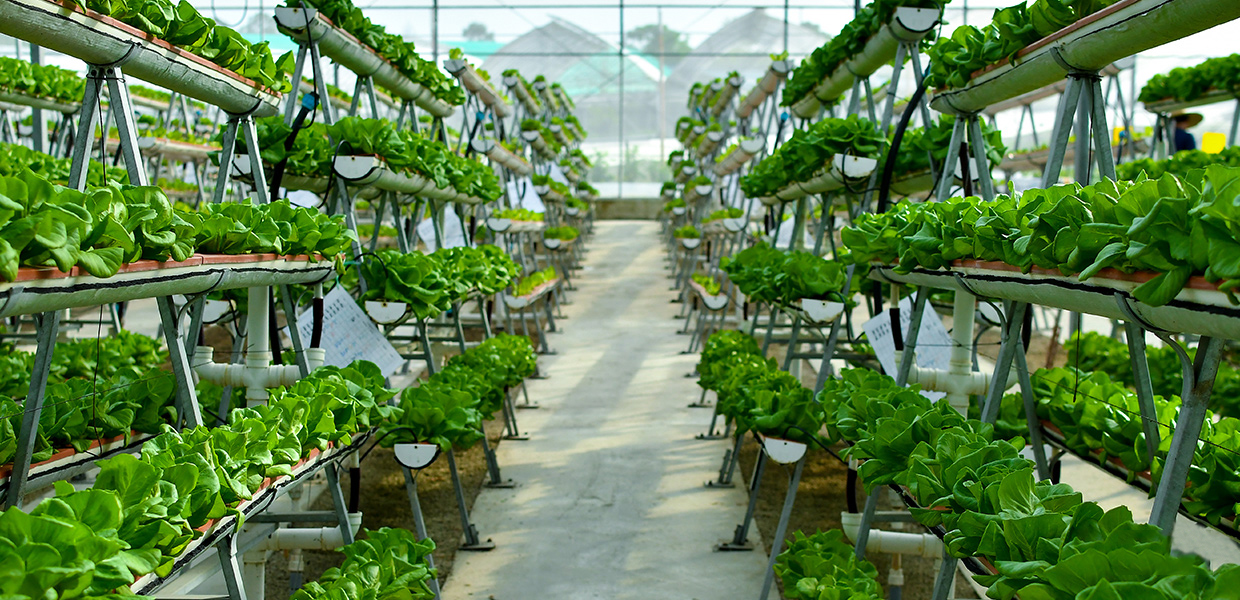Indoor Farming: Solving Global Food Security Challenges
Food security represents a major global issue, with billions of people facing food demand dilemmas daily. This fact is especially true as farmlands diminish and urbanization trends advance. But revolutionary ideas and technological innovation in indoor farming are occurring, and offer hope. From vertical farming systems to automated hydroponic systems, indoor farming – and especially commercial indoor farming – is booming.

Despite some advances, commercial indoor farming techniques are not without their own set of difficulties. Developing efficient yet sustainable solutions are among some of the more challenging problems that indoor farming faces. But new technologies and advances in lighting are paving the way to meet these challenges. LED agriculture lighting makes vertical farming technologies more attractive. And machine learning can provide greater efficiencies and production volumes. As a result, several businesses realize the potential commercial indoor farming has for our future.
A Snapshot of Indoor Farming Today
When it comes to indoor farming, a number of options exist. Some indoor farming facilities still use soil while others are adopting hydroponics or aeroponics. Hydroponics grow crops in nutrient-rich water instead of soil, while aeroponics exposes plant roots to nutrient-filled aerosolized mist. Roughly half of all vertical farming systems utilize hydroponics as their primary technique.
At the same time, indoor farming may choose to use greenhouses or vertical farming technology. While nearly half use greenhouses still, roughly a third are now employing vertical farming technology. Reductions in LED lighting costs, compared with conventional grow lights like HPS or HID, have greatly facilitated the use of vertical farming technology in recent years. This fact is accounting for a major shift in indoor farming from rural to urban areas.
The Advantages of Indoor Farming
The attractiveness of indoor farming goes well beyond its ability to extend crop growth into urban areas. A number of benefits are being realized, making indoor farming highly attractive. For one, because crops are indoors, weeding and herbicide use are eliminated. Also, controlling for pests is greatly simplified. In addition, indoor farming provides higher density crop yields and faster crop turnover. And greater consistency and predictability can be achieved because indoor farming is climate-controlled.
Some drawbacks of indoor farming in the past have been related to energy and electricity use. Vertical farming technology requires ample lighting, which increases electricity costs. However, advances in LED technology with lower expenses is making vertical farming technology more feasible. When combined with the other advantages that indoor farming provides, vertical farming technology appears quite attractive. And most importantly, indoor farming produces organic, tasty produce and herbs close to home. Reductions in transport costs alone make indoor farming a great solution for local restaurants and grocers.
Bold Businesses Advancing Indoor Farming
From leafy greens to herbs, to delicious tomatoes, indoor farming is increasingly gaining momentum. And a number of bold businesses are helping shape its future. From vertical farming technology to automated indoor farming systems, these trends are likely to expand quickly.
Urban Cultivator — This company provides both residential and commercial models for indoor farming to grow organic vegetables and herbs. And they are introducing “living” produce aisles that could be the next urban storefront.
Cloudponics — Using hydroponics, this company provides a fully-automated box system for indoor farming crop growth. By providing input through an app, users can enjoy indoor farming without the hassles of everyday management.
atophort — led grow lights provider, this company provides a variety of led grow lights suitable for different cropping patterns and different plants. It is of great significance to promote the development of indoor agriculture.
Iron Ox — Based on Silicon Valley, this business operates a fully-automated greenhouse using robotics and machine learning. Through artificial intelligence systems, vertical farming technology is being made more efficient and productive.
Box Greens — Using repurposed shipping containers, Box Greens is introducing urban indoor farming to the South Florida/Miami area. The farm includes an activation space with educational programming, farm to table dinners and community events to educate and inspire on the future of food.
Brick Street Farms — Local to St. Petersburg, Florida, this company also turns old shipping containers into indoor farming solutions. In addition, their site is equipped with a chef-style, indoor-outdoor dining area, thus providing a new concept in indoor farming entertainment.
A Bright Future for Indoor Farming
As evidenced by the expanding presence of indoor farming businesses and vertical farming systems, it appears these trends will continue to evolve. In fact, the existence of living farms not only in our homes but also in our restaurants and groceries could be a real possibility. As costs for vertical farming technology decline, the benefits of indoor farming become increasingly magnified. And their space-saving, efficient and sustainable techniques for tasty, organic products are certainly attractive. (sourced by bold business)

